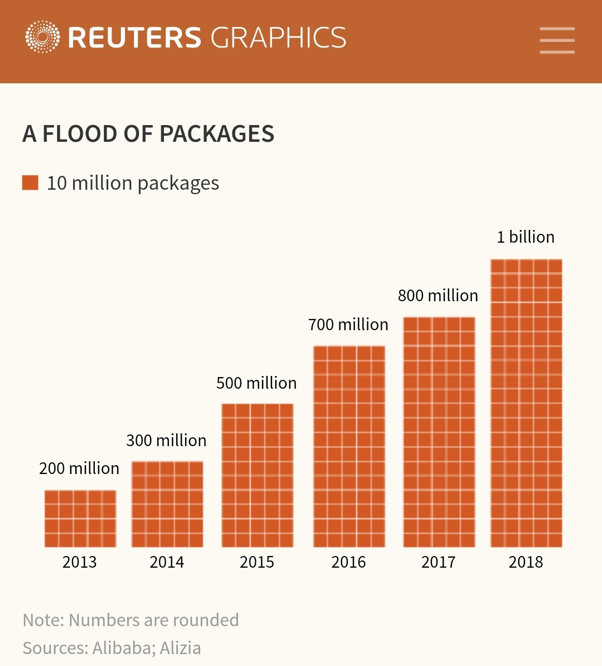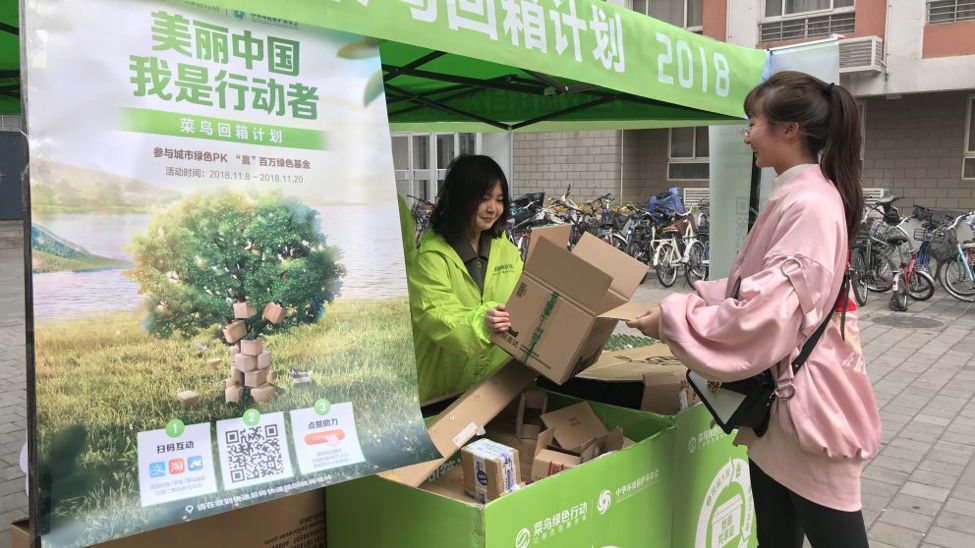
While the West focuses on the faltering Paris climate agreements, China is on track to beat its emissions targets and leapfrog into a more sustainable future through the use of advanced technology.
Already in its 11th year, the 11.11 Global Shopping Festival, also known as “Double 11” or “Single’s Day,” is the largest e-commerce day in the world. Alibaba generated US$38.4 billion in gross merchandise value during this year’s event – in just 24 hours. In comparison, Amazon’s two-day “Prime Day” sale, held this past July, generated an estimated $7.16 billion. Still, a critical question is whether Chinese firms are making a meaningful effort to balance consumerism with sustainability.
The original concept behind 11.11 was that it was an anti-Valentine’s Day, a shopping holiday for single Chinese consumers to treat themselves with gifts bought via e-commerce. Now, it’s for all consumers, regardless of their attachment status, and Alibaba estimated that about 500 million people would participate in this year’s event. Importantly, for many of China’s modern consumers, they now have access to products and services that were previously available only to the wealthy elite. For Alibaba, this is all powered by a global network of 200,000 brands in 78 countries and regions.
There are many reasons why the 11.11 event has exploded in popularity, including the use of augmented-reality technology and livestreaming in Alibaba’s new online storefronts and increasingly regular appearance of mega-celebrities such as Kim Kardashian West on the platform. There’s also Alibaba’s unique mix of entertainment and shopping, as seen during the 11.11 Countdown Gala, which was seen globally in 106 countries and regions and featured performances by Taylor Swift. Independent of Silicon Valley, China’s technology infrastructure and consumer habits are evolving rapidly.
For Alibaba, 11.11 is not just about promoting consumption. The day has become a critical way to stress-test China’s entire digital economy. In 2012, 11.11 generated 50 million package deliveries in a single day and crashed the nation’s delivery system. To prevent this bottleneck from happening again, Alibaba launched its own smart logistics network, called Cainiao, and further developed the ability for digital-payments platform Alipay to handle higher transaction volumes.

What’s critical about this technological approach is that it not only creates resiliency in the ecosystem to handle future shocks, but it also improves overall efficiency in resource management during the rest of the year. However, record sales also mean Alibaba needs to address another alarming challenge: the environmental challenge posed by this economic activity.
The growth of Chinese consumption has accelerated at a bewildering pace, with a rising middle class (projected to reach 550 million people by 2022) and the rapid digitization of factories and rural areas. Poverty alleviation in rural areas has been an important social good produced by this e-commerce activity, with more than $97.6 billion and 6.83 million jobs generated in rural areas by Alibaba in 2018. Unfortunately, the sheer scale of this economic activity requires serious concern about what this means for sustainability and environmental stewardship.
The demand from this new group of empowered consumers is daunting, and represents an enormous challenge for society. The production and distribution of these goods, especially from promotional events like 11.11, lead to unprecedented amounts of energy consumption, and the production of millions of tons of waste materials.
Consumers and companies alike are contributing to this environmental challenge. With rural communities rising out of poverty and consumer demand showing no signs of slowing, the entire digital economy needs to develop new methods of engaging and educating this new generation of consumers about best practices in sustainability.
To that end, technology companies, including Alibaba, are incentivizing their user base to create positive social change. This year, over 18 million users were activated through Alibaba’s “Green 11.11” campaigns, which rewarded consumers with digital currency and coupons when they participated in sustainability programs. And it is worth noting that since the inception of Ant Financial’s Ant Forest green initiative, over 500 million consumers have activated this mini-app to track their low-carbon footprint through daily actions and have used their collective credits to plant more than 120 million actual trees in China, as recognized by the United Nations Environment Program.
Given the aforementioned 500 million shoppers participating in this year’s 11.11, Alibaba’s efficient logistics and accessible recycling programs are critical to reducing waste. Cainiao has introduced smart technology that improves packaging efficiency by 15%. In the past year, over 150 million eco-friendly packages were shipped through Tmall without using any plastic tape.
These smart systems are powered by Alibaba’s data centers, which traditionally require huge amounts of energy to operate and cool. However, since 2014, the tech giants in China have had data centers strategically constructed in Guizhou province, where the mountainous terrain provides natural cooling and are powered by renewable hydroelectric power.

To address the cardboard waste generated by 11.11, Cainiao designated Nov. 20 as “National Cardboard Box Recycling Day,” using 75,000 recycling stations to facilitate the returns and marking them on Alibaba’s navigation app, Amap, which is the market leader in China with 340 million monthly active users. Through Tmall and Xianyu, Alibaba’s market for second-hand goods, 40,000 types of digital appliances are eligible for recycling and upgrade programs.
Local and national policy are also working to spur change with impressive agility. This past July, the Shanghai municipal government implemented strict new recycling policies, and virtually overnight every business and residential area had adopted color-coded bins to handle the trash-sorting requirements. The entire city was abuzz with discussion about the new rules, but by now, most Shanghai locals understand the four-category system. While the national government set a target to recycle 35% of its trash by 2020, Shanghai residents took it upon themselves to raise their recycling rate from 15% to 80% within a mere three months. While sustainability in developed countries can often feel like an abstract ideal, environmental stewardship in China is a critical health issue, and even urban Shanghai residents have stepped up to meet the challenge.
As COSFCO International Chairman Johnny Chi Jingtao noted in a recent WEF article, “China has invested a total of $378.5 billion in 16 major sustainability programs, which exceeds any other national sustainability program. On the commercial side of sustainability, China is now at the cutting edge of solar technology, low-carbon transport, the circular economy, carbon trading and more. China is serious about sustainability.” China is already on track to meet its Paris Accord carbon goals nine years earlier than planned.
Many outside observers still carry notions of China as a country not doing enough to address pollution and environmental issues. China certainly has room for improvement in these areas, but as another record-setting 11.11 comes and goes, hopefully skeptics can look more closely to see China for what it really is: a place where where sustainability programs are being implemented rapidly and emissions are being slashed dramatically.
This article was co-authored by Brian Lee, an associate at RADII China, a China-focused media platform.




